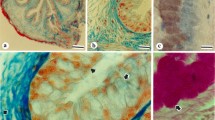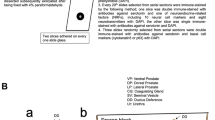Summary
The majority of the secretory cells in the tubular endpieces of the caprine bulbourethral gland are mucous cells. Their closely packed, relatively large secretory granules exhibit a low electron density. Some granules have lost their limiting membrane, this results in the accumulation of irregularly outlined masses of secretory material. All mucous secretory granules are PAS-positive, many of them are characterized by an alcianophilia at pH 2.5 which is extinguished by pre-treatment with a neuraminidase solution. The second type of secretory bulbourethral cell exhibits light, spherical nuclei, a well developed rough endoplasmic reticulum with dilated cisterns and a large supranuclear Golgi-Complex. The cytoplasm contains smaller, highly electron dense granules which are — according to histochemical tests — of protein nature. The existence of transitional forms between both described cell types permits the conclusion that they must be regarded as functional stages of one common gland cell. The secretory surface of both cell types is increased by intercellular canaliculi which can be identified in the light microscope by their strong ATPase and 5′-nucleotidase activities. The entire parenchyma of the gland is site of an exceptionally high esterase concentration. Furthermore, the gland cells contain considerable amounts of β-D-galactosidase, β-D-glucuronidase, leucine aminopeptidase, cytochrome oxydase and succinic dehydrogenase. These last five enzymes are histochemically more active in the protein secreting than in the mucus producing cell type.
Zusammenfassung
Die Mehrzahl der sezernierenden Zylinderzellen in den tubulösen Endstücken der Glandula bulbourethralis der Ziege sind Schleimzellen. Ihre großen, aufgehellten Sekretgranula, die fast den gesamten Zelleib ausfällen, liegen so dicht, daß sie sich gegenseitig abplatten. Einzelne von ihnen haben ihre Hüllmembran verloren und neigen zur Konfluenz. Alle Schleimkörnchen sind PAS-positiv, viele von ihnen zeigen eine neuraminidaselabile Alcianophilie bei pH 2,5. Neben den Schleimzellen findet man in der Glandula bulbourethralis der Ziege einen zweiten Zelltyp, der durch helle, blasenförmige Kerne, ein stark entfaltetes granuläres endoplasmatisches Retikulum mit dilatierten Zisternen sowie ein ausgedehntes supranukleares Golgi-Feld gekennzeichnet ist. Dieser zweite Zelltyp enthält sehr elektronendichte, isoliert liegende Sekretkugeln, welche lichtmikroskopisch eine Proteinreaktion geben. Zwischen beiden Zelltypen kommen morphologische Übergangsformen vor. Dies macht es wahrscheinlich, daß es sich bei den beiden Typen lediglich um Funktionsstadien einer einzigen Drüsenzelle handelt. Die sezernierende Oberfläche beider Zelltypen ist durch die Ausbildung interzellulärer Sekretkapillaren vergrößert. Diese sind bereits lichtmikroskopisch aufgrund ihrer kräftigen ATPase- und 5′-Nucleotidaseaktivität zu identifizieren. Das gesamte Drüsenparenchym reagiert sehr stark auf unspezifische Esterase und deutlich positiv auf β-D-Galactosidase, β-D-Glucuronidase, Leucinaminopeptidase, Cytochromoxydase und Succinatdehydrogenase. Die letzten 5 Enzyme sind in den Schleimzellen in geringerer Konzentration festzustellen als in den Zellen mit Eiweißgranula.
Similar content being viewed by others
Literatur
Burstone, M. S.: Histochemical demonstration of eytochrome oxydase with new amine reagents. J. Histochem. Cytochem. 8, 64–70 (1959).
—: Enzyme histochemistry and its application in the study of neoplasms. New York and London: Acad. Press 1962.
Deimling, O. H. v.: Die Darstellung phosphatfreisetzender Enzyme mittels Schwermetall-Simultan-Methode. Histochemie 4, 48–55 (1964).
Elson, D.: Ribosomal enzymes. In: Enzyme cytology, ed. by D. B. Roodyn. London and New York: Acad. Press 1967.
Feagans, W., Robertson, Z. K.: Histochemical and electron microscopical observations of the hamster bulbourethral duct and associated glands. Anat. Rec. 148, 280–281 (1964).
Gomori, G.: Histochemical specifity of phosphatases. Proc. Soc. exp. Biol. (N. Y.) 70, 7–11 (1949).
Greenstein, J. S., Hart, R. G.: The contribution of Cowper's glands to coagulation and plug formation of rat semen. Anat. Rec. 148, 287 (Abstr.) (1964).
Grzycki, S., Latalski, M.: Observations on the fine structure of rat bulbourethral gland cells. Z. mikr.-anat. Forsch. 80, 190–202 (1969).
Halbhuber, J., Geyer, G.: Histochemischer Nachweis von Sialomucin in den Glandulae bulbourethrales et vestibulares majores. Acta histochem. (Jena) 21, 143–149 (1965).
Hart, R. G.: The mechanism of action of Cowper's secretion in coagulating rat semen. J. Reprod. Fertil. 17, 223–226 (1968).
—, Greenstein, J. S.: A newly discovered role for Cowper's gland secretion in rodent semen coagulation. J. Reprod. Fertil. 17, 87–94 (1968).
Hess, R., Scarpelli, D. G., Pearse, A. G. E.: The cytochemical localization of oxydative enzymes. II. Pyridine nucleotide-linked dehydrogenase. J. biophys. biochem. Cytol. 4, 753–760 (1958).
Jerusalem, C.: Eine kleine Modifikation der Goldner-(Masson)-Trichromfärbung. Z. wiss. Mikr. 65, 320–321 (1963).
Knieling, K.: Vergleichende Untersuchungen über den Bau der Glandulae bulbo-urethrales einiger männlicher Säuger unter spezieller Berücksichtigung der durch Entfernung der Testes entstehenden Veränderungen. Inaug.-Diss. Leipzig 1910.
Krölling, O., Grau, H.: Lehrbuch der Histologie und vergleichenden mikroskopischen Anatomie der Haustiere, 10. Aufl. Berlin u. Hamburg: Paul Parey 1960.
Lillie, R. D.: Histopathologic technic and practical histochemistry, 2nd ed. New York-Toronto-Sidney-London: McGraw-Hill Book Co. 1954.
Marois, M., Salesses, A.: Contribution à l'étude histochimique de la glande bulbo-urétrale du rat. Ann. Histochim. 13, 105–110 (1968).
Nachlas, M. M., Crawford, D. T., Seligman, A. M.: The histochemical demonstration of leucine aminopeptidase. J. Histochem. Cytochem. 5, 264–278 (1957).
—, Seligman, A. M.: The histochemical demonstration of esterase. J. nat. Cancer Inst. 9, 415–425 (1949).
—, Walker, D. G., Seligman, A. M.: A histochemical method for the demonstration of diphospho-pyridine nucleotide diaphorase. J. biophys. biochem. Cytol. 4, 29–38 (1958).
Pasztor, L., Schaetz, F.: Die künstliche Besamung beim Schwein. I. Physiologie der Geschlechtsorgane. In:Die künstliche Besamung bei den Haustieren. Hrsg. F. Schaetz. Jena: VEB G. Fischer Verlag 1963.
Rutenburg, A. M., Rutenburg, S. H., Monis, B., Teague, R., Seligman, A. M.: Histochemical demonstration of β-D-galactosidase in the rat. J. Histochem. Cytochem. 6, 122–129 (1958).
Seligman, A. M., Tsou, K. C., Rutenburg, S. H., Cohen, R. B.: Histochemical demonstration of β-glucuronidase with a synthetic substrate. J. Histochem. Cytochem. 2, 209–229 (1954).
Steedman, H.: Alcian blue 8 GS, a new stain for mucin. Quart. J. micr. Sci. 91, 477–479 (1950).
Wrobel, K. H.: Morphologische Untersuchungen an der Glandula bulbourethralis der Katze. Z. Zellforsch. 101, 607–620 (1969).
Author information
Authors and Affiliations
Additional information
Mit dankenswerter Unterstützung durch die Deutsche Forschungsgemeinschaft.
Rights and permissions
About this article
Cite this article
Wrobel, K.H. Untersuchungen zur Feinstruktur und Histochemie der Glandula bulbourethralis der Ziege. Z. Zellforsch. 108, 582–596 (1970). https://doi.org/10.1007/BF00339660
Received:
Issue Date:
DOI: https://doi.org/10.1007/BF00339660




